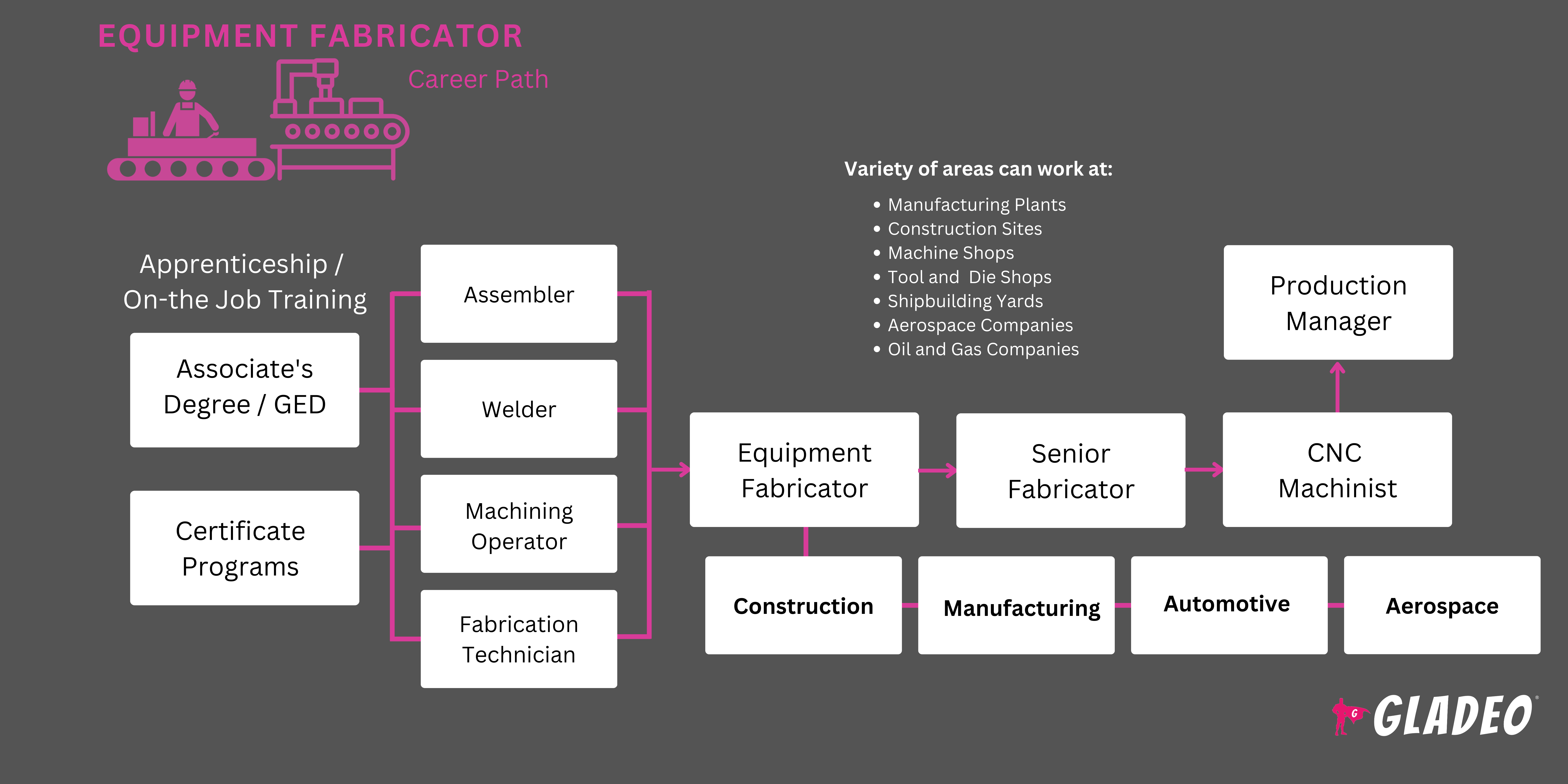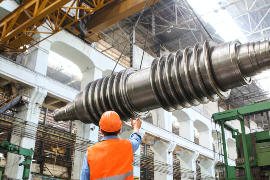Spotlights
Equipment Technician, Equipment Assembler, Equipment Maintenance Technician, Equipment Operator, Equipment Engineer, Manufacturing Technician, Fabrication Specialist, Mechanical Assembler, Machine Builder, Production Technician
The term “equipment” covers thousands of different items used in countless industries. Bulldozers, blenders, blood pressure monitors. Computers, car jacks, dumbbells. Voltage testers, Bunsen burners, fire extinguishers…the list goes on and on.
Equipment is used to perform or assist with all sorts of tasks and functions. It’s usually purchased commercially and “off-the-shelf,” meaning it already exists and is easy to buy. But sometimes there are tasks that need doing—and no existing equipment designed to do them! That’s where Equipment Fabricators come in to save the day.
As a process, fabrication is related to machining but involves more cutting, bending, welding, shearing, and forming pieces. Machining, on the other hand, relies more on milling, turning, drilling, grinding, and lathing.
Fabricated equipment refers to custom-made devices or tools specially created for unique purposes. Such equipment may include customized machines for industrial purposes, special rigs for filming, tailored medical devices, research and lab apparatus, vehicle modifications, sporting gear, etc. Whatever it is, Equipment Fabricators are always up for the challenge!
- Getting to design, manufacture, and assemble new equipment to help organizations meet their goals
- Potentially making something that will revolutionize an industry
- Unique opportunities for skills development
Lịch làm việc
- Equipment Fabricators work full-time jobs, typically with nights, weekends, and holidays off, though overtime may be occasionally needed to stay on schedule.
Nhiệm vụ tiêu biểu
- Meet with managers or clients to review their requirements for fabricated equipment
- Brainstorm ideas for what such equipment might look like, its features, and the estimated cost of productionIf multiple pieces of equipment are needed, review manufacturing procedures and costs
- Create or review written descriptions or sketches, blueprints, technical drawings, etc.
- Agree upon the terms of work, including timelines and budgets
- Collaborate with team members, including engineers or consultants, as needed
- Request the equipment, tools, and raw materials necessary to begin work
- Use hand tools and operate machines to fabricate workpieces. Assemble parts when ready
- Mark cutting lines on materials; check to ensure pieces are securely fitted and aligned
- Examine parts or final products for quality assurance
- Conduct stress tests and troubleshoot prototypes to ensure proper functioning before submitting them for review
- Garner feedback and make adjustments
Trách nhiệm bổ sung
- Attend equipment/product development meetings
- Adhere to safety standards and guidelines
- Create detailed reports of all work
- Write or help write operation manuals for new equipment
- Stay up-to-date on applicable software and technical manuals
- Train and mentor new fabricators, machinists, operators, technologists, and technicians, as needed
- Giữ khu vực làm việc sạch sẽ và thực hiện bảo trì định kỳ trên máy móc
Kỹ năng mềm
- Sự tỉnh táo
- Phân tích
- Thận trọng
- Kỹ năng giao tiếp
- Định hướng tuân thủ
- Tư duy phản biện
- Định hướng chi tiết
- Kỷ luật
- Độc lập
- Mục tiêu
- Tổ chức
- Kiên nhẫn
- Lập kế hoạch và tổ chức
- Giải quyết vấn đề
- Safety-consciousness
- Phán xét hợp lý
- Stamina
- Làm việc theo nhóm
- Quản lý thời gian
Kỹ năng kỹ thuật
- Đọc bản thiết kế
- Welding/metalwork
- Machining and machinist programs such as Armchair Machinist and Machinists’ Calculator
- Computer-aided design programs like Autodesk AutoCAD, CATIA, PTC Creo Parametric, and SolidCAM
- Computer-aided manufacturing software like Autodesk Fusion 360 and CNC Mastercam
- Industrial control software such as EditCNC or Mazak Mazatrol
- Procedure management programs like Hexagon Metrology PC-DMIS
- Precision measurement tools (calipers, micrometers, and gauges)
- Knowledge of materials and their properties (including various types of metal and metal alloys such as steel, brass, aluminum, copper, zinc, lead, vanadium, and manganese)
- Familiarity with tools and equipment such as welding machines, shears, presses, grinders, CNC machines, lasers, plasma cutters, waterjets, measuring instruments, and safety gear
- Làm quen với hệ thống thủy lực, hệ thống dây điện, chất bôi trơn và pin
- Safety procedures and first aid
- Aerospace industry
- Agribusiness
- Ngành công nghiệp ô tô
- Computer and electronic product manufacturing
- Các công ty xây dựng
- Food processing industry
- Sản xuất máy móc
- Oil and gas companies
- Renewable energy sector
- Nghiên cứu và phát triển
- Temporary help services
- Sản xuất thiết bị vận tải
Equipment fabricators must maintain high levels of precision and deliver quality prototypes and finished products that meet their employer’s or client’s expectations. Work must be done safely, within established timeframes and budgets, and in compliance with applicable industry standards.
These numerous demands put a lot of pressure on fabricators, whose work is heavily scrutinized. When things get behind schedule, they may have to put in extra hours to catch up. It’s a physically demanding job, involving lifting, prolonged standing, and exposure to various hazards—all of which can take a toll over time.
Trends in the field of equipment fabrication include the rise of Industry 4.0, which uses technologies like automation, artificial intelligence, Cyber-Physical Systems, cloud computing, 3D printing, and the Internet of Things to improve efficiency and productivity.
For equipment that will be mass-produced, the Industrial Internet of Things enables manufacturers to connect machines, devices, and sensors to the Internet. This allows real-time data collection, helping to optimize operations. Sustainable Manufacturing is another growing trend, as companies seek to reduce waste, improve energy efficiency, and utilize renewable resources. However, this may be less important for customized equipment that will only be made once or a few times.
Equipment Fabricators enjoy visualizing ideas and using their hands to bring them to life. They are comfortable using tools and stationary heavy equipment. They might have enjoyed math and shop classes in school, as well as design and computer programming.
For them, it’s easy to collaborate but they don’t mind working alone for long periods where they can focus on the task at hand. They might have been highly independent growing up, and thus feel right at home completing projects without a ton of interaction with others.
- Equipment Fabricators need at least a high school diploma or GED
- Many workers in this field pursue a certificate or associate’s degree at a community college or technical school to learn or brush up on:
- Toán
- Đọc bản thiết kế
- Welding/metalwork
- Safe hand tool usage
- CAD/CAM programs
- How to operate CNC machines
- Các khóa học phổ biến khác bao gồm:
- Aluminum Projects
- Bending
- Notching
- Part Forming & Construction
- Mill & Lathe Operations
- Sheet Metal Shaping
- Plasma Cutting
- Sponsored apprenticeships or internships are another way to get training, so include those keywords when searching for job posts online
- Fabricators can also learn their skills via specialized programs like those from The Fab School. Check out related course offerings from Coursera, too!
- Optional certification programs can demonstrate Equipment Fabricators' commitment to quality, such as:
- Equipment Fabricators don’t need to attend a four-year university. But a certificate or associate’s at a technical school or community college will come in handy
- Xem xét chi phí học phí, giảm giá và cơ hội học bổng địa phương (ngoài viện trợ liên bang)
- Think about your schedule and flexibility when deciding whether to enroll in an on-campus, online, or hybrid program. Many relevant courses will need to be done in person to get hands-on experience
- Xem lại số liệu thống kê vị trí việc làm của chương trình cho sinh viên tốt nghiệp
- Sign up for plenty of math, physics, computer science, materials science, and shop classes in high school
- Cân nhắc tìm hiểu về vẽ cơ học và đọc bản thiết kế thông qua tự học
- Tham gia các lớp học trực tuyến đặc biệt từ Coursera , Udemy hoặc các trang web khác
- Enroll in a community college or vocational/technical school program to learn fabrication methods, welding, CAD/CAM, CNC machining, etc.
- Knock out a certification program such as AISC’s Certified Fabricator or AWS Certified Welder
- Tham gia vào một chương trình thể dục có thể xây dựng sức mạnh và sức chịu đựng của bạn
- Get some real-world job experience via part-time jobs or internships related to fabrication or shop work
- Request to do an informational interview with a working Equipment Fabricator to learn about their jobs
- Theo dõi các địa chỉ liên hệ có thể đóng vai trò là người giới thiệu công việc trong tương lai
- Study books, articles, and video tutorials related to traditional and modern fabrication processes, tools, and equipment
- Tham gia vào các diễn đàn trực tuyến để đặt câu hỏi và học hỏi từ những chuyên gia dày dạn kinh nghiệm
- Tham gia với các tổ chức chuyên nghiệp để học hỏi, chia sẻ, kết bạn và phát triển mạng lưới của bạn (xem danh sách Tài nguyên > Trang web của chúng tôi)
- Bắt đầu tạo sơ yếu lý lịch sớm. Tiếp tục thêm vào nó khi bạn tiếp tục, để bạn không bị mất dấu bất cứ điều gì

- Kiểm tra các cổng thông tin việc làm như Indeed.com, LinkedIn, Glassdoor, Monster, CareerBuilder, SimplyHired hoặc ZipRecruiter
- Look on Craigslist for job postings from smaller local companies
- Make a list of local equipment manufacturing companies and visit their websites’ career pages frequently
- Advertise your services online, such as on LinkedIn or via a website
- Seek out apprenticeships or internships sponsored by employers, unions, or trade associations
- Ask a working Equipment Fabricator for job-seeking tips
- Visit your school’s career center for assistance finding job fairs, writing a resume, and connecting with recruiters
- Giữ liên lạc với các bạn cùng lớp và sử dụng mạng của bạn để nhận các mẹo công việc. Hầu hết các công việc vẫn được tìm thấy thông qua các kết nối cá nhân
- Hỏi người hướng dẫn, người giám sát cũ và / hoặc đồng nghiệp của bạn nếu họ sẵn sàng phục vụ như là tài liệu tham khảo cá nhân. Không cung cấp thông tin liên hệ cá nhân của họ mà không có sự cho phép trước
- Check out some Equipment Fabricator-related resume examples and sample interview questions
- Practice doing mock interviews and learn how to dress appropriately for interviews
Master your current job but let your supervisor know you’re interested in career progression. Express your willingness to complete additional training
- Study equipment and software operation manuals and become proficient with the tools you use
- Collaborate well with others and communicate clearly and honestly about the details of a project you’re assigned. If there is a challenge, explain it and try to offer solutions
- Ensure projects are kept on schedule and on-budget
- Keep track of fabrication, welding, and machining trends and advancements
- Consider specializing and getting advanced certifications in a challenging area, such as gas tungsten arc or laser hybrid welding
- Đối với những người làm việc tại các tổ chức nhỏ hơn, bạn có thể phải nộp đơn xin làm việc cho một loại hình tổ chức lớn hơn hoặc khác để kiếm được mức lương cao hơn hoặc đạt được mục tiêu nghề nghiệp cao hơn
- Hoàn thành các chứng nhận nâng cao của bên thứ ba cũng có thể hữu ích. Các tùy chọn bao gồm:
- AISC’s Certified Fabricator
- AWS Certified Welder
- Certified Composite Technician
- Certified Robotic Arc Welding
- National Institute for Metalworking Skills certifications
- NCCER’s Certified Metal Fabricator
- SME’s Certified Manufacturing Technologist
- A bachelor’s in mechanical engineering or a related field can open up additional career opportunities and provides a deeper understanding of engineering principles, materials science, and design concepts
Trang web
- American Composites Manufacturers Association
- American Foundry Society
- Viện Xây dựng Thép Hoa Kỳ
- American Machine Tool Distributors’ Association
- Hiệp hội Kỹ sư Cơ khí Hoa Kỳ
- Hiệp hội hàn Hoa Kỳ
- Hiệp hội nhà chế tạo & nhà sản xuất, quốc tế
- IPC
- International Association of Sheet Metal, Air, Rail, and Transportation Workers (SMART)
- National Center for Construction Education and Research (NCCER)
- Viện Kỹ năng gia công kim loại quốc gia
- Hiệp hội gia công và dụng cụ quốc gia
- Hiệp hội sản phẩm gia công chính xác
- Society of Manufacturing Engineers (SME)
Sách vở
- Composite Material Fabrication Handbook #1, by John Wanberg
- Learn to Weld: Beginning MIG Welding and Metal Fabrication Basics, by Stephen Christena
- Sheet Metal Workers Pocket Manual, by Fred Schumacher and Calude Zinngrabe
- Welding for Beginners: The Secrets To Welding, Cutting, and Shaping Metal Like a True Professional, by Cosmo Castro
Equipment Fabricator can be a very rewarding career choice! It’s filled with opportunities to do creative work with your hands, making custom pieces of equipment to help employers or clients overcome challenges and reach their objectives. But if this doesn’t sound quite right for you, here are some related occupations to consider:
- Aircraft Structure, Surfaces, Rigging, and Systems Assembler
- Nhà sản xuất nồi hơi
- Coil Winder, Taper, and Finisher
- Electrical and Electronic Equipment Assembler
- Electromechanical Equipment Assembler
- Engine and Other Machine Assembler
- Fiberglass Laminator
- Cơ khí máy móc công nghiệp
- Thợ sắt
- Machinery Maintenance Worker
- Metal and Plastic Machine Worker
- Millwright
- Công nhân kim loại tấm
- Structural Metal Fabricator and Fitter
- Timing Device Assembler
- Thợ hàn
Nguồn cấp tin tức

Việc làm nổi bật

Các khóa học và công cụ trực tuyến







